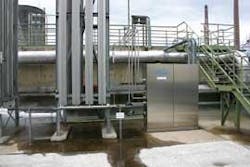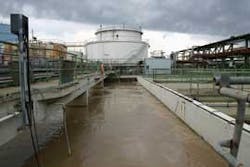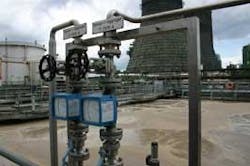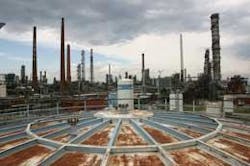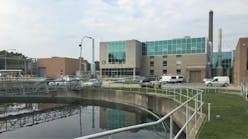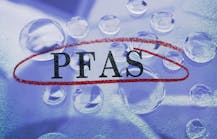Shell Deutschland Oil GmbH clarifies its refinery wastewater with a new oxygen transfer process that surpasses far-reaching regulatory standards imposed on companies that channel wastewater into the Rhine River.
The cryogenic liquid oxygen of Linde is converted into gas phase in the evaporators using ambient heat.
Freshwater Asian clams, sable, tubenose gobies and a hypania invalida worm - these species may sound incredibly exotic to our ears, but they actually live in Germany. All of them splash around in the Rhine, the water quality of which has improved remarkably over the last few years.
A few decades ago the Rhine was considered one of the most polluted rivers in the world, but salmon have begun to feel at home in the river again since a large-scale environmental clean-up programme began improving water quality at the end of the 1980s. Far-reaching regulations imposed on companies in the area about channelling wastewater into the river have been taken seriously, and river water quality has improved.
Shell Deutschland Oil GmbH, which has a factory in Godorf near Cologne is also obliged to maintain these strict regulations for pumping wastewater from its refinery into the Rhine. So that the wastewater is clarified even further than is actually required, Shell converted its wastewater reservoirs to the reliable oxygen transfer system, Solvox®, by the Linde Gas Division of Linde AG. “We put cleaner water back into the Rhine than already flows in the river”, says Steffen Eggers, head of the system at Shell Deutschland Oil GmbH in Godorf. “I live a few kilometres downriver from our factory, and love swimming in the Rhine with my children.”
Right next-door was the Rheinische Olefinwerke GmbH (now Basell), a company founded jointly by Badische Anilin und Sodafabrik (BASF) and what was then Deutsche Shell AG. Basell is still one of the main customers for certain refinery products that are used for manufacturing plastics. The location directly on the Rhine was also one of the most convincing arguments - for trouble-free procurement of cooling water and easy transportation by ship - as was the position in one of the largest German regional states, right at the heart of a conurbation. Finally, in 1960, Deutsche Shell AG’s largest refinery was opened in Godorf, and by 1967 an entire secondary plant complex consisting of distillation and further processing systems had been put into operation to meet increasing demand during the economic boom. An increasing awareness for the environment, technical progress and a change in market demand called for continuous adaptation, expansion and improvements to the plants. Today, the plant in Godorf is one of the most modern, high-performance works in Germany. Meanwhile, it belongs to the Shell Deutschland Oil GmbH Rhineland Refinery Network. Some ten million tonnes of crude oil are processed in Godorf every year.
No refinery would be complete without a wastewater system. Wastewater is produced from various sources during the processing of crude oil. The different types of process water that are polluted with different substances must be purified before they can be fed back into the Rhine. Indeed, the same strict compliance with fixed limits also applies for rainwater before it can be directed into the Rhine. “As far as introducing water into the river is concerned, we are subject to a fixed quantity and quality for all our wastewater,” Eggers explained. “Our official ‘water introduction authorisation’ allows us to release up to 260 m3 of wastewater an hour into the Rhine. We have set up internal measuring points at the outlets. The Federal Environmental Agency also controls the purity of the water here on a regular basis,” he added.
Target-specific injection of oxygen
Shell operates a classic biological purification plant with physical and chemical preliminary purification in Godorf for purification of the process wastewater. “Strictly speaking, a wastewater system is a copy of nature in miniature”, said Eggers. “We have to offer the many tiny life forms like rotifers and vorticellidae, and also microorganisms, the best possible living conditions, so that they can do in large numbers but in a small volume of water exactly what they do in all natural waters. If you look at it this way, our biological basins are less a technical plant than a biological community.” Since the bacteria are only able to adapt slowly to changes in the wastewater pollutants, wastewater from the different processing stages is brought together and mixed.
Target-specific injection of oxygen
First, the mixed water runs through the preliminary purification stage. The introduction of certain liquid chemicals causes substances in the wastewater like oils, turbidity-causing solids and dispersions to flocculate. In the following flotation process, flocs rise to the surface and are skimmed off in bags by a circular sludge collector. The floated sludge is thickened and then disposed of or burned. The water that has been pre-purified in this way can then be sent on to the biological purification system. Three activation basins connected in series stand ready to take in this water in Godorf, although about 90% of the biological degradation process actually takes place in the first and largest basin. The three activation basins have a total volume of 4,280 m3 and process on average a wastewater volume of 4,320 m3 per day. The organic compounds contained in the wastewater consist mainly of carbon, hydrogen and nitrogen. Since degradation of the organic substances in natural waters causes oxygen deficiency, they are already converted microbially in the purification plant into carbon dioxide, ammonium and water.
Elimination of the nitrogen contained in ammonium, which is what causes over-fertilisation in natural waters, takes place next in two stages, which Eggers describes like this: “First the metabolic activity of the bacteria during the so-called nitrification process oxidises ammonium into nitrate. In order to do this, the tiny microorganisms need oxygen, in the same way as they do for hydrocarbon degradation. The second step, which is known as denitrification, is carried out under exclusion of oxygen. In this process, methanol is added, due to a lack of easily degradable carbon compounds. Specialised bacteria use the nitrate oxygen to convert the methanol into carbon dioxide and water. Here, elementary nitrogen is formed from the nitrate, and is stripped out of the water.”
The intermittent denitrification method is used at the Godorf works. The two process stages of nitrification and denitrification take place one after the other in one basin. In the past, oxygen transfer was carried out in the basin by surface aeration; however this did not produce satisfactory results. For this reason, Shell decided in 2001 to convert to a more effective oxygen transfer process. Shell awarded the contract for the entire conversion job to the Linde Gas Division of Linde AG, which has many years of experience in the application of technical gases in wastewater treatment. Linde supplies processes specially developed for environmental technology in addition to the necessary hardware. Linde works in close co-operation with customers to adapt processes for specific applications in order to implement the best ecological and economical solution.
Shell conversion to Solvox
The changeover to oxygen transfer took place in November 2002 within two weeks. Linde neither had to expand or alter the Shell water treatment plant. The new oxygen transfer system was built into the three activation basins instead of the surface aeration system that had previously been used.
“Our Solvox processes allow a fast and uncomplicated increase in the purification performance in most cases without any time-consuming conversion work,” explained Volker Knab of the Application Engineering Department at the Linde Gas Division of Linde AG. “We built two Solvox-I units SI30 into the second basin and two Solvox-I units SI10 into the third basin.” Knab is responsible for the project.
It was not possible to achieve optimum results in clearing basin one with the standard Solvox units due to the geometry of the basin and the extremely high nitrogen levels. Knab explained: “In basins two and three, the oxygen transfer with Solvox works excellently, but in basin one, oxygen utilisation was too low, since the oxygen bubbles cover too short a distance from the floor of the basin to the surface. In order to achieve even better results in basin one, we used twelve special six-jet ejectors instead of the Solvox units, which guarantee the best possible oxygen utilisation in existing conditions. The solution to this problem finally lead to us developing a new standard series called Solvox-V.”
View of the refinery plant complex of Shell Deutschland Oil GmbH, Rhineland Refinery Network Godorf
The system conversion secured many advantages to the wastewater purification in the Shell facility: high nitrogen elimination, lower aerosol and odour emissions, improved sludge settling, and no random denitrification in the final purification stage. The system is flexible even when there are high load fluctuations, and involves low time and cost expenditure for testing and regulating technology. The savings achieved by this system are considerably greater than the cost of supplying oxygen. According to Eggers, “We carried out an acceptance test, in which clean and de-gassed water was pumped into the basins and then gassed with oxygen. We then measured the oxygen concentration in relation to time to determine how high the oxygen utilization is. The test gave extremely good results.”
Author’s Note
Gabi Wilhelm of MM Mertig Marktkommunikation is based in Munich, Germany. For more information, contact Volker Knab, Application Engineering Department, Linde AG, Geschaftsbereich Linde Gas, Cologne, Germany, E-Mail: [email protected], www.linde.de.
